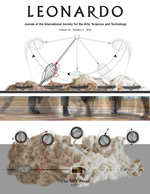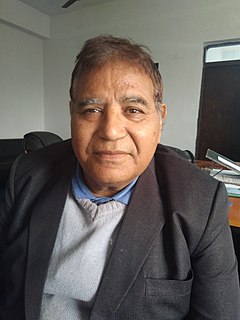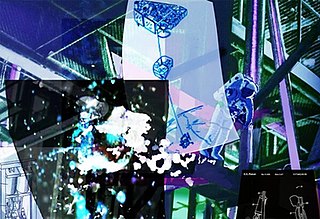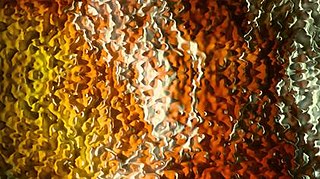Citations
- ↑ "Leonardo On-Line: Leonardo Award Winners".
- ↑ "Order the Best American Essays 2007, ISBN: 0618709274 | HMH". Archived from the original on 2014-03-19. Retrieved 2014-03-19.
- ↑ http://www.mitpressjournals.org/page/editorial [ dead link ]
George Gessert is one of the best-known artists in the contemporary art movement known as bio-art a/k/a BioArt. Gessert began his career as a painter and printmaker, and began breeding plants as an art form in the late 1970s. Beginning in the 1980s, Gessert's work focused on the overlap between art and genetics, and he has exhibited a series of installations of hybrids and documentation of breeding projects.
George Gessert was born in 1944 in Milwaukee, Wisconsin. He has a BA in English from the University of California at Berkeley 1966 and an MA in Fine Arts from the University of Wisconsin-Madison in 1969.
Gessert creates his artistic irises by hybridizing wild varieties and discarding undesirable results. He is especially interested in plant aesthetics and ways that human aesthetic preferences affect evolution. Gessert calls his practice "genetic folk art," and his work points to the way nature is interpreted—even authored—by humans. Gessert's work mainly focuses on irises and other ornamental flowers.
Gessert's awards include the Leonardo Award for Excellence [1] and the Pushcart prize for his essay, "Notes on Uranium Weapons and Kitsch." His article, "An Orgy of Power" was included in Best American Essays 2007. [2] Gessert is also an Editorial Board Member of Leonardo Journal published by MIT Press for Leonardo/ISAST, the International Society for the Arts, Sciences and Technology. [3]
Information art, which is also known as informatism or data art, is an emerging art form that is inspired by and principally incorporates data, computer science, information technology, artificial intelligence, and related data-driven fields. The information revolution has resulted in over-abundant data that are critical in a wide range of areas, from the Internet to healthcare systems. Related to conceptual art, electronic art and new media art, informatism considers this new technological, economical, and cultural paradigm shift, such that artworks may provide social commentaries, synthesize multiple disciplines, and develop new aesthetics. Realization of information art often take, although not necessarily, interdisciplinary and multidisciplinary approaches incorporating visual, audio, data analysis, performance, and others. Furthermore, physical and virtual installations involving informatism often provide human-computer interaction that generate artistic contents based on the processing of large amounts of data.

Eduardo Kac [ɛdwardoʊ kæts; ĕd·wâr′·dō kăts] (1962) is an American contemporary artist whose artworks span a wide range of practices, including performance art, poetry, holography, interactive art, telematic art and transgenic art. He is particularly well known for his works that integrate biotechnology, politics and aesthetics.
Gregory Stock is a biophysicist, best-selling author, biotech entrepreneur, and the former director of the Program on Medicine, Technology and Society at UCLA’s School of Medicine. His interests lie in the scientific and evolutionary as well as ethical, social and political implications of today's revolutions in the life sciences and in information technology and computers.

Critical Art Ensemble (CAE) is a collective of five tactical media practitioners of various specializations including computer graphics and web design, film/video, photography, text art, book art, and performance. For CAE, tactical media is situational, ephemeral, and self-terminating. It encourages the use of any media that will engage a particular socio-political context in order to create molecular interventions and semiotic shocks that collectively could diminish the rising intensity of authoritarian culture.

Frank Joseph Malina was an American aeronautical engineer and painter, especially known for becoming both a pioneer in the art world and the realm of scientific engineering.
Elliot Meyerowitz is an American biologist.
New media art journals are academic journals covering the topic of new media art. They can be published in physical or online format and typically include original research, interviews, and information about books, events and exhibitions that incorporate technology in the arts.

BioArt is an art practice where humans work with live tissues, bacteria, living organisms, and life processes. Using scientific processes such as biotechnology the artworks are produced in laboratories, galleries, or artists' studios. The scope of BioArt is considered by some artists to be strictly limited to "living forms", while other artists would include art that uses the imagery of contemporary medicine and biological research, or require that it address a controversy or blind spot posed by the very character of the life sciences.

Leonardo is a peer-reviewed academic journal published by the MIT Press covering the application of contemporary science and technology to the arts and music.

Hybrid art is a contemporary art movement in which artists work with frontier areas of science and emerging technologies. Artists work with fields such as biology, robotics, physical sciences, experimental interface technologies, artificial intelligence, and information visualization. They address the research in many ways such as undertaking new research agendas, visualizing results in new ways, or critiquing the social implications of the research. The worldwide community has developed new kinds of art festivals, information sources, organizations, and university programs to explore these new arts.
Ryszard Slomski is a Polish professor and lecturer at the Poznań University of Life Sciences.

Nina Czegledy is a Canadian artist, new media art curator and writer.
Bhyravabhotla Radhakrishna Murty (1928–2003) was an Indian botanist, known for his contributions the fields of Conservation genetics and Radiation genetics. He was a professor of Biochemistry Division at Indian Agricultural Research Institute, Pusa and was an elected fellow of Indian Academy of Sciences and the Indian National Science Academy. The Council of Scientific and Industrial Research, the apex agency of the Government of India for scientific research, awarded him the Shanti Swarup Bhatnagar Prize for Science and Technology, one of the highest Indian science awards, in 1973, for his contributions to biological sciences.
Sushil Kumar was an Indian geneticist and academic, known for his Plant and microbial genetical genomics, especially the studies on Escherichia coli and Lambda phage as well as on the mutants of Rhizobium. He was a former director of the Central Institute of Medicinal and Aromatic Plants of the Council of Scientific and Industrial Research and an elected fellow of the Indian National Science Academy, National Academy of Agricultural Sciences, National Academy of Sciences, India, and Indian Academy of Sciences. The Council of Scientific and Industrial Research, the apex agency of the Government of India for scientific research, awarded him the Shanti Swarup Bhatnagar Prize for Science and Technology, one of the highest Indian science awards, in 1981, for his contributions to biological sciences.
Elizabeth Demaray is a sculptor and interdisciplinary artist known for her inquiries into the interface between the built and the natural environment.

Rishi Kumar Behl is an Indian scientist, professor, and author.

Daniel Gianola is a geneticist based at the University of Wisconsin-Madison (US), reputed for his contributions in quantitative genetics to the fields of animal and plant breeding. In the early 1980s, Gianola extended best linear unbiased prediction to the non-linear domain for analysis of categorical traits, using the classical threshold model of Sewall Wright. Subsequently, he pioneered the use of Bayesian methodologies and Monte Carlo Markov chain methods in quantitative genetics. He also revived early work by Sewall Wright on structural equation models and cast their application in the context of modern quantitative genetics and statistical methodology. His group in Wisconsin was the first in the world applying non-parametric methods, such as reproducing Kernel Hilbert spaces regression and Bayesian neural networks, to genome-enabled selection in animal breeding, agriculture and whole-genome prediction of complex traits or diseases. Gianola published extensively on thresholds models, Bayesian theory, prediction of complex traits using mixed model methodology, hierarchical Bayesian regression procedures and machine learning techniques. Gianola has been also involved in whole-genome prediction of skin and bladder cancer in humans. He has taught extensively in more than twenty countries including recurrent visiting professorships at the Universidad Politecnica de Valencia (Spain), the Norwegian University of Life Sciences (Norway), Aarhus University (Denmark), Georg-August University (Germany) and the Technical University of Munich (Germany). He has been an Honorary Researcher at the Pasteur Institut de Montevideo since 2016. In an Editorial contained in a volume published in Gianola's honor in the Journal of Animal Breeding and Genetics (2017), it was stated that "He is probably the one lecturer in animal breeding and genetics, who has the biggest impact on the largest number of followers in the numerous classes and courses he has taught with never-ending energy all across the world."
Leonardo, The International Society for the Arts, Sciences and Technology (Leonardo/ISAST) is a registered 501c(3) nonprofit formed in 1982 as an umbrella organization for the journals Leonardo and the Leonardo Music Journal. In 2018, Leonardo/ISAST was awarded the Golden Nica Prix Ars Electronica as Visionary Pioneers of New Media Art.

Ellen K. Levy is an American multimedia artist and scholar known for exploring art, science and technology interrelationships since the early 1980s. Levy works to highlight their importance through exhibitions, educational programs, publications and curatorial opportunities; often through collaborations with scientists including NASA, some in conjunction with Leonardo, the International Society for the Arts, Sciences and Technology. She is a past president of the College Art Association and has published widely on art and complex systems.

Patricia Olynyk is a Canadian born American multimedia artist, scholar and educator whose work explores art, science, and technology-related themes. Known for collaborating across disciplines and projects that explore the mind-brain relationship, interspecies communication and the phenomenology of perception, her work examines "the way that experiences and biases toward scientific subjects affect interpretations in specific contexts."